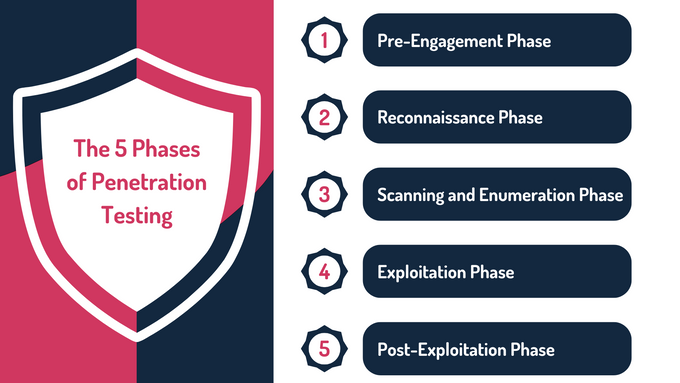Penetration Testing Steps From Pre-Engagement to Reporting
Explore the critical stages of penetration testing, from initial planning to final reporting, and how GRSee delivers in-depth vulnerability analysis to strengthen system defenses.
Published April 5, 2025.

As cybersecurity threats become more sophisticated, penetration testing has become essential to a robust security strategy. By simulating real-world cyberattacks, it helps organizations identify weaknesses in their defenses and provides actionable insights for remediation. This multi-step process uncovers specific vulnerabilities in various system areas.
Beyond aiding compliance with standards like PCI DSS, ISO 27001, and SOC2, penetration testing ultimately enhances an organization’s ability to protect its data, systems, and reputation against evolving threats. It also assesses the adequacy of existing security controls to withstand modern cyberattacks.
» Let the experts handle your penetration testing needs with our startup and enterprise services
What Is Penetration Testing?
Penetration testing, also known as ethical hacking, is a deliberate, authorized simulation of a cyberattack against a system, application, or network. The goal is to identify vulnerabilities and security weaknesses before malicious hackers can exploit them.
» Read about the different types of penetration tests
4 Key Goals of Penetration Testing
- Identify vulnerabilities: Penetration testing is essential because it exposes weaknesses in applications, networks, and systems that might otherwise go unnoticed during routine security checks.
- Test security measures: Pentesters assess the effectiveness of security systems like firewalls, intrusion detection systems, and policies. By trying to breach these defenses, organizations can gain insights into whether their existing controls are sufficient or need further enhancement.
- Assess compliance: Testing ensures compliance with industry standards like PCI DSS, ISO 27001, or SOC2.
- Provide actionable recommendations: Pentesters offer detailed, practical solutions to mitigate discovered vulnerabilities. This includes clear guidance on how to improve the organization’s security posture.
» Enhance your security with penetration testing and PCI DSS training
5 Phases of Penetration Testing
1. Pre-Engagement Phase
During the pre-engagement phase, the client and testing team collaborate to define specific objectives, ensuring alignment on key priorities such as identifying security gaps or compliance requirements.
Additionally, this phase involves planning the assets to be tested, scheduling the test, and addressing legal considerations like permissions and privacy regulations. A well-defined pre-engagement plan ensures that the test is efficient, minimally disruptive, and thoroughly compliant with necessary laws and standards.
Rules of Engagement
The Rules of Engagement (RoE) document defines the testing framework for penetration tests. In simple terms, it sets the parameters regarding what will be tested, when, and how, ensuring the objectives are aligned.
Key Elements for Rules of Engagement
Scope Definition
Identify the assets to be tested. These may include specific networks, systems, applications, or physical assets. The scope also outlines any systems that should not be tested.
Timeframe
Establish a testing schedule, whether it occurs during business hours or during off-peak times to minimize disruption.
Legal Boundaries
Penetration testers need explicit legal permission from the organization to avoid legal implications. The scope must also respect privacy and compliance rules.
2. Reconnaissance Phase
The reconnaissance phase involves detailed data collection on the target environment, which helps testers map out potential vulnerabilities. Testers may leverage tools like port scanners and network mappers to identify open ports, services, and any public-facing assets.
During this phase, both passive and active reconnaissance methods are used:
Passive Reconnaissance
Passive reconnaissance uses non-intrusive methods to gather information about the target without direct engagement:
- Techniques such as open source intelligence (OSINT) involve collecting publicly available data from websites, social media, and public databases.
- The primary advantage is that it goes unnoticed by the target, as it does not directly interact with their systems.
Active Reconnaissance
Active reconnaissance involves directly engaging the target's network to gather more specific and actionable data:
- Tools like Nmap are commonly used to scan networks and services, while DNS interrogation can uncover subdomains and internal network structures.
- The primary advantage is that it provides a more detailed view of the network but comes with the risk of detection.
Take note: In both passive and active reconnaissance, gathering essential data about the target is crucial for guiding subsequent testing phases. Key information includes network topology, which helps plan attack routes, and identifying IP address ranges and subdomains to define the target’s scope.}
» Secure your business with our professional penetration testing services
3. Scanning and Enumeration Phase
Scanning identifies various aspects of a system that may be vulnerable to exploitation by attackers. This information can highlight possible attack vectors, such as outdated software versions or services that are improperly exposed to external networks.
4 Types of Scans
In the scanning phase, there are different types of scans, each focusing on different aspects of the system to uncover potential vulnerabilities and weaknesses:
- Port scanning: Port scanning identifies which ports on a system are open and could potentially be exploited by attackers. Tools like Nmap are commonly used to check port status and analyze the services running behind them.
- Vulnerability scanning: Vulnerability scanning involves using tools like Nessus or OpenVAS to search for known vulnerabilities in systems or applications. These scans help uncover outdated software versions, misconfigurations, or other weaknesses that may expose the network to attacks.
- Service scanning: Service scanning detects services running on open ports and identifies their version numbers. This allows testers to determine if these services are vulnerable to specific known exploits.
- Application scanning: Application scanning focuses on identifying flaws in web applications and APIs. Tools like ZAP or Burp Suite are used to detect vulnerabilities such as SQL injection or cross-site scripting (XSS).
» Learn more about security assessments with vulnerability scanning vs penetration testing
4 Enumeration Techniques
Enumeration allows testers to gather crucial details such as user accounts, shared resources, active directories, and network services that are open to exploitation:
- Service enumeration: Service enumeration identifies the specific features and configurations of services running on a system, such as which protocols and ports are in use. This helps narrow down potential attack vectors for exploitation and provides insights into the system’s overall security posture.
- Banner grabbing: Banner grabbing collects information from service banners, revealing software versions and configurations. This data helps pinpoint outdated or vulnerable software, providing potential targets for attacks.
- User enumeration: User enumeration involves extracting user lists and group memberships, especially in active directory environments. Understanding who has access to specific systems aids in identifying potential access points.
- Application enumeration: Application enumeration focuses on identifying key application components, user roles, and access controls in web applications or APIs. This information is crucial for finding vulnerabilities tied to user privileges and role-based access, allowing for targeted exploitation.
4. Exploitation Phase
The exploitation phase involves leveraging the vulnerabilities identified in earlier stages to gain unauthorized access to systems, applications, or data. During this phase, penetration testers carefully plan and execute attacks that could mimic real-world threats.
Vulnerability Prioritization
Vulnerability prioritization is crucial in penetration testing, as it allows testers to address the most critical weaknesses first. This involves evaluating vulnerabilities based on their potential impact, ease of exploitation, and public exposure, enabling testers to focus on risks that pose the greatest threat.
Impact and risk: Vulnerabilities that expose critical systems or sensitive data, like SQL injection leading to unauthorized access to a customer database, are prioritized due to the potential for significant harm.
Exploitability: Easier-to-exploit vulnerabilities, such as default administrative credentials or weak passwords, are ranked higher. An exposed login page with default credentials poses a high risk.
Exposure: Publicly known or unpatched vulnerabilities, especially those with available exploits, receive urgent attention. A zero-day vulnerability in widely-used software like Apache can be targeted by attackers globally, highlighting the need for rapid remediation.
Exploitation Techniques
Web Application Exploitation Techniques
- SQL injection: Attackers manipulate SQL queries to gain unauthorized access to backend databases, potentially extracting sensitive data like usernames and passwords. This could lead to unauthorized administrative control over the application.
- Cross-site scripting: Malicious scripts are injected into a web page, allowing attackers to steal session cookies or impersonate users. In certain cases, attacks can be especially harmful when combined with social engineering tactics.
- Command injection: Pen testers exploit vulnerabilities that allow attackers to execute arbitrary commands on the server, gaining control over the system. These attacks can lead to complete system compromise if executed successfully.
- Buffer overflow: Attackers send oversized data inputs, causing systems to crash or enabling the execution of malicious code, which can lead to remote code execution and full control of affected systems.
Network Vulnerabilities Exploitation Techniques
- Broken authentication: Exploiting flaws in authentication allows attackers to bypass login credentials and access sensitive user accounts. This can lead to privilege escalation and data breaches when combined with other vulnerabilities.
- SMB relay attacks: These attacks intercept and relay authentication requests over the network, tricking systems into granting unauthorized access.
- Misconfigured services: Exploiting improperly configured network services exposes internal systems and sensitive data. This is particularly damaging when default settings remain unchanged, allowing for easy breaches.
3 Steps Penetration Testers Use for Safe and Effective Security Testing
1. Controlled Testing
Testers often use isolated environments or virtual machines to run exploits, ensuring that any unintended system crashes or changes do not affect live production systems. This practice allows testers to simulate real attacks without causing disruptions in actual operational environments.
2. Backup and Recovery Plans
Before beginning the testing phase, penetration testers work with the client to establish a comprehensive backup and recovery plan. This ensures that if any system malfunctions or data corruption occurs during testing, the system can be restored to its previous state with minimal downtime.
3. Coordination With the Client
Ongoing communication with the client is essential to ensure critical systems are identified and avoided during the testing phase. Pen testers coordinate with the client to schedule tests during off-peak hours and verify which systems should be excluded from testing to prevent disruptions in vital services.
5. Post-Exploitation Phase
The post-exploitation phase focuses on assessing the impact and depth of access gained by exploiting vulnerabilities. It involves determining how far an attacker could have gone within a compromised system, evaluating the sensitivity of data accessed, and assessing the overall damage that could result from the breach.
Activities Performed in Post-Exploitation
- Data collection: Pentesters gather sensitive information, such as confidential data and system configurations, to assess the extent of the breach.
- Privilege escalation: Testers attempt to elevate their access within the system to gain higher-level permissions and evaluate the risk of compromised accounts.
- Persistence: In controlled scenarios, backdoors are temporarily installed to determine whether continued access is possible but are removed afterward.
- Impact assessment: Testers analyze the potential damage caused by vulnerabilities, including data loss, financial harm, or system compromise.
Take note: During the post-exploitation phase, it's essential that penetration testers maintain detailed logs of all actions taken, documenting every step to ensure transparency and accountability. After testing, any access points or changes made to the system must be thoroughly removed to restore the system to its original state.
Reporting and Briefing
After all the phases of the penetration tests have been finished, testers can consolidate their findings and present them to the client in a structured format. This is important because it not only outlines the vulnerabilities found but also offers a roadmap for remediation and provides critical insights for the risk assessment process.
Penetration testing reports typically contain the following:
- Executive summary: A high-level overview for stakeholders, explaining the scope, key findings, and overall security posture without technical jargon.
- Technical findings: Detailed descriptions of each vulnerability, including severity ratings, technical implications, and how these issues were exploited during the test.
- Remediation recommendations: Actionable steps for addressing each vulnerability, prioritized by severity. The recommendations guide clients on how to strengthen security controls and reduce their attack surface.
- Evidence and logs: Documentation of the testing process, including screenshots, logs, and other data showing how vulnerabilities were exploited.
» Learn more about what’s involved in the risk assessment process
Conducting Penetration Tests With GRSee
At GRSee, our comprehensive approach to penetration testing extends beyond just identifying vulnerabilities. We provide end-to-end support, from pre-engagement through to remediation, starting with an in-depth gap analysis to assess your security posture. Our team simulates real-world attacks to reveal true system weaknesses, and we offer ongoing post-assessment support to not only patch vulnerabilities but also help you develop long-term security strategies that protect your organization from future threats.
» Contact us to strengthen your security with GRSee’s comprehensive penetration testing and long-term security strategies






